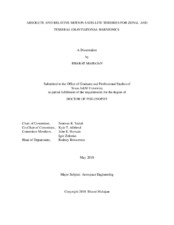Absolute and Relative Motion Satellite Theories for Zonal and Tesseral Gravitational Harmonics
Abstract
In 1959, Dirk Brouwer pioneered the use of the Hamiltonian perturbation methods for constructing
artificial satellite theories with effects due to nonspherical gravitational perturbations included.
His solution specifically accounted for the effects of the first few zonal spherical harmonics.
However, the development of a closed-form (in the eccentricity) satellite theory that accounts
for any arbitrary spherical harmonic perturbation remains a challenge to this day. In the present
work, the author has obtained novel solutions for the absolute and relative motion of artificial satellites
(absolute motion in this work refers to the motion relative to the central gravitational body)
for an arbitrary zonal or tesseral spherical harmonic by using Hamiltonian perturbation methods,
without resorting to expansions in either the eccentricity or the small ratio of the satellite’s mean
motion and the angular velocity of the central body. First, generalized closed-form expressions
for the secular, long-period, and short-period variations of the equinoctial orbital elements due
to an arbitrary zonal harmonic are derived, along with the explicit expressions for the first six
zonal harmonics. Next, similar closed-form expressions are obtained for the sectorial and tesseral
(collectively referred to as tesserals henceforth) harmonics by using a new approach for the exact
Delaunay normalization of the perturbed Keplerian Hamiltonian. This approach reduces the solution
for the tesseral periodic perturbations to quadratures. It is shown that the existing approximate
approaches for the normalization of the tesseral problem, such as the method of relegation, can be
derived from the proposed exact solution. Moreover, the exact solution for the periodic variations
due to the tesseral harmonics produces a unified artificial satellite theory for the sub-synchronous
and super-synchronous orbit regimes without any singularities for the resonant orbits. The closedform
theories developed for the absolute motion are then used to develop analytic solutions in the
form of state transition matrices for the satellite relative motion near a perturbed elliptic reference
orbit. The expressions for differential equinoctial orbital elements for establishing a general circular
orbit type satellite formation are also derived to avoid singularities for the equatorial and
circular reference orbits. In order to negate the along-track drifts in satellite formations, an ana-
lytic expression for the differential semimajor axis is derived by taking into account the secular
effects due to all the zonal harmonics. The potential applications of the proposed satellite theories
range from fuel-efficient guidance and control algorithms, formation design, faster trade and
parametric studies to catalog maintenance, conjunction analysis, and covariance propagation for
space situational awareness. Two specific applications, one for solving a perturbed multiple revolution
Lambert’s problem and the other for rapid nonlinear propagation of orbit uncertainties using
point clouds, are also given. The theories presented in this work are implemented for computer
simulations in a software tool. The simulation results validated the accuracy of these theories and
demonstrated their effectiveness for various space situational awareness applications.
Subject
Artificial Satellite TheoriesZonal and Tesseral Spherical Harmonics
Canonical Perturbation Methods
Satellite Relative Motion
Formation Flying
Relative Motion STM
Perturbed Lambert Solver
Formation Drift Mitigation
Citation
Mahajan, Bharat (2018). Absolute and Relative Motion Satellite Theories for Zonal and Tesseral Gravitational Harmonics. Doctoral dissertation, Texas A & M University. Available electronically from https : / /hdl .handle .net /1969 .1 /173295.


